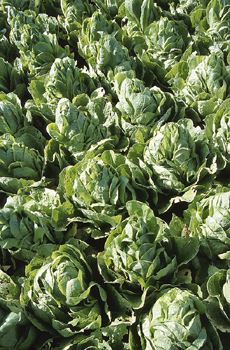The Ten Healthiest Vegetables to Grow and Eat
Your grandparents or great grandparents most likely had a Victory Garden in their backyard. During the times of food rationing in World War I and II, people were encouraged to grow food in their back yards to ease the food shortage, and as a sign of patriotism and defiance. The garden itself was a sign of victory. It gave ordinary people a chance to feel like they were contributing to the war effort.
Today, the Victory Garden is back in style. But instead of victory over a foreign enemy, we celebrate victory over a sluggish economy, poor health, contaminated and overly processed foods.  When you grow your own fruits and vegetables, you’re taking responsibility for your health into your own capable hands. Most of us weren’t raised on a farm, and gardening may not come naturally. But if you take your time, and allow yourself a few failures along the way, you’ll soon be an expert gardener and eating fresher, more nutritious foods than ever before.
When you grow your own fruits and vegetables, you’re taking responsibility for your health into your own capable hands. Most of us weren’t raised on a farm, and gardening may not come naturally. But if you take your time, and allow yourself a few failures along the way, you’ll soon be an expert gardener and eating fresher, more nutritious foods than ever before.
How to know what to grow
You’ll need to consider your space first. Some vegetables need a plot of land with room to spread out. But many can be grown in a coffee can or even an old boot! Container gardening is part agriculture, part eclectic art. You’ll also need to consider things like growing season, light and water availability, and what you plan to do with a bumper crop. Will you eat everything fresh? Or will you want to preserve, pickle or freeze some of the crop? Make sure you have the space and materials for your storage. If your freezer is full of zucchini, there’s not much room for ice cream.
Most importantly, though, what do you like to eat? And what is most nutritious? Staples like corn and potatoes are plentiful and cheap, so it’s best to put your efforts toward more nutrient dense crops. Here’s a list of the top 10 most nutritious garden veggies. Remember, a garden is a thing of pleasure. Don’t plant a veggie you hate just because it’s on the list. Substitute you favorites in.
Leafy greens
These babies are some of the easiest veggies to grow and come in lots of varieties–spinach, kale and collards are some of the most nutritious greens. “You’ll get more calcium in a bowl of fresh greens than in any dairy product,” says Dr. Brahm, a dentist in Glastonbury, CT. They’re also high in iron, potassium, and Vitamins A, B6, and C.
Broccoli
If you love broccoli, grow lots of it! Broccoli gives you plenty of calcium, iron, and magnesium, as well as Vitamin A, B6, and C. Just one cup of raw broccoli is 130% of your daily recommendation for Vitamin C.
Tomatoes
Tomatoes are some of the most popular garden residents. They contain lots of fiber, iron, magnesium, niacin, potassium, and Vitamin A, B6, and C. They’re also a great source of the antioxidant lycopene. And, well, they’re just so darn tasty!
Bell Peppers
Red bell peppers are high in potassium, riboflavin, and Vitamins A, B6, and C – in fact, one cup of red bell pepper packs an amazing 317% of the recommended daily allowance of Vitamin C and 93% of the recommended Vitamin A.
Garlic & Onions
Onions, leeks and garlic, besides being tasty, contain high levels of antioxidants and phytonutrients. Allicin (the key ingredient) is a known anti-viral, anti-bacterial and anti-fungal agent. You also get lots of vitamin C, B6 and manganese.
Carrots
Carrots are best grown in loose soil without a lot of rocks, which make them hard to grow in some areas. If you have the right conditions, they’re a great choice–very high in fiber, manganese, niacin, potassium, and Vitamins A, B6, and C.
Peas
The only downside to these common garden veggies is it’s hard to get them back to the house without eating them all. Peas are high in fiber, iron, magnesium, potassium, and Vitamin A, B6, and C. They also store well frozen, canned or dehydrated.
Beans
We’re not talking about green beans here, but the kind you can dry and store indefinitely like kidney beans and black beans. Dry beans, in general, are high in iron, fiber, manganese, and phosphorous. They are also a staple protein for vegetarians.
Sweet Potatoes
Sweet potatoes are a great source of nutrition, as long as you stay away from the brown sugar and marshmallows. You’ll get lots of fiber, potassium, manganese and vitamins A, C and B6.
Brussels Sprouts
These baby cabbages get a bad rep from kids, but these fiber-rich veggies pack some serious nutrition. They are a great source of thiamin, riboflavin, iron, magnesium, phosphorus, folate, potassium, manganese and copper, Vitamins A, C, K and B6. Vitamin C, Vitamin K, Vitamin B6,
Whether you’re trading your lawn for a garden plot or just planting a few container veggies, you can’t beat the health benefits of fresh air and fresh food.
